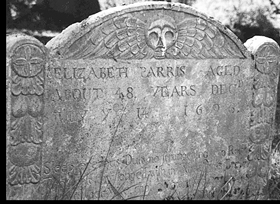The Beginning
Despite all that has been written about Salem witchcraft, the origins of the outbreak remain obscure. According to one contemporary account, penned by the Reverend John Hale of Beverly, it started "in the latter end of the year 1691." Hale's calculation was based upon the Julian calendar, which began the year on March 25. By present-day reckoning, which was already the popular custom when Hale wrote, this would be sometime before March 25, 1692 in our present-day calendar. Another contemporary account, by the Boston merchant Robert Calef, places the onset of events more precisely at "the latter end of February 1691," which mean the end of February 1692. Recent historical writing locates the beginning as early as mid-January 1692.
What happened and where it happened is more certain than the timing. In the house of Salem Village's minister, Samuel Parris, the minister's daughter, Elizabeth, and niece, Abigail Williams, aged nine and about eleven, began to exhibit "strange and unusual" behavior. Other neighboring youngsters displayed the same disturbing behavior, either simultaneously or shortly thereafter. These included Elizabeth Hubbard, aged seventeen, who lived with her uncle, the physician William Griggs, and Anne Putnam, Jr., the twelve-year-old daughter of Thomas Putnam, Jr., a mainstay of Parris's church. The afflicted young girls reportedly behaved bizarrely "as by getting into Holes, and creeping under Chairs and Stools, and to use sundry odd Postures and Antick Gestures, uttering foolish, ridiculous Speeches, which neither they themselves nor any others could make sense of . . ." Many historical accounts claim that the initial afflictions were an emotional reaction to experiments in fortune-telling, during which divining techniques intended to foretell their future husbands' calling evoked, instead, a frightening image of a coffin. The evidence for this incident, however, is not conclusive, and many historians are skeptical it occurred. It is impossible to say with certainty what precipitated the fits in Parris's household.
However distressing, their strange condition was not immediately attributed to witchcraft. Parris later recalled that it was "several weeks" before witchcraft was suspected. Three circumstances brought matters to a head. First, Parris's attempt to to restore the girls by traditional religious nostrums of fasting and prayer proved ineffectual. Second, a diagnosis was made by a local physician, Dr. Griggs, that the young people were under the "Evil Hand" of witchcraft. And thirdly, the group's behavior became noticeably more distracted in response to an experiment in counter-magic conducted by one of Parris's female congregants, Mary Sibly, an aunt of one of the afflicted. Sibly directed Parris's male "Indian," servant, familiarly known as John Indian, to bake a cake containing the urine of the afflicted girls in hopes of discovering who was bewitching them. Whether Griggs's diagnosis provoked the resort to counter-magic or the cake prompted the behavior that led to Griggs's diagnosis is unknown. Whatever the case, at the end of February 1692, the pursuit of witches was underway. Likely encouraged and pressured by Parris, Thomas Putnam, and other adults, some of the afflicted girls named three Salem Villagers as responsible for harming them — Tituba Indian (John Indian's wife), Sarah Good, and Sarah Osborne. Formal complaints were made against the three witches, and on February 29, warrants were issued for their arrest. They were brought before two local magistrates, who conducted a hearing to determine whether there was sufficient grounds to be held for consideration by a grand jury, which could lead to indictment and trial. The Salem witch hunt was underway.
To find out more about the community of Salem Village, click Next.
